It doesn’t matter if you are looking for a keyboard piano to start learning how to play it or if you are an experienced player looking to upgrade your equipment, you will definitely need a high-quality instrument. The best keyboard piano must be able to simulate the traditional acoustic piano while also being supplied with some advanced features for the creation of more complex music.
Thanks to technical progress, now we have several types of pianos, one of which is a keyboard piano. One of its greatest advantages is its design. Unlike the traditional pianos, the keyboards pianos offer not considerable weight and portability while also having a decent quality despite the compact size. This way, you can easily move it around or store somewhere when it’s not in use. It’s also a perfect choice for traveling musicians who simply don’t have the ability to transport the full-sized piano together with the luggage. However, it’s universal not only in terms of portability but also in terms of usage as it can be used at home, in studio, or at live concerts.
This way, if you are a pianist who values portability but don’t want to sacrifice the sound quality, opt for a keyboard piano. However, just like the traditional piano, the keyboard piano is a kind of instrument that is usually chosen to serve for long. This way, you should consider a lot of factors before making your choice. The models from our list vary greatly in terms of offered features, simplicity of usage, etc. Plus, to simplify your choice of the best keyboard piano, our buyer’s guide contains information about the most important factors that you should consider when making your decision.
Keyboard Piano Reviews
RockJam RJ561
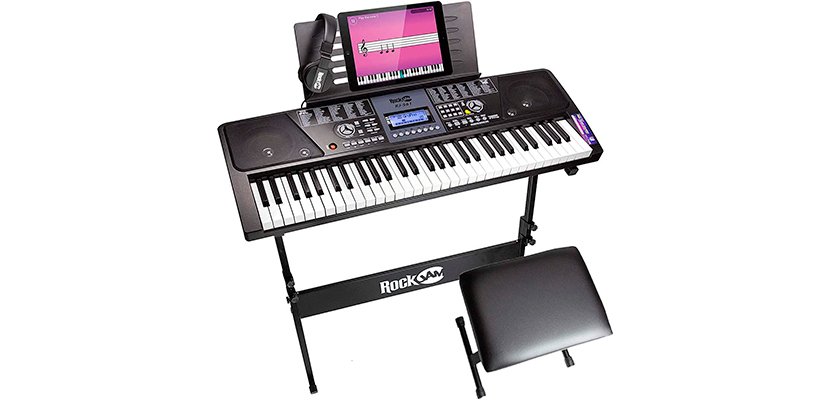
This electronic keyboard from RockJam has 61 full-size keys. In terms of functionality, there are record and playback functions, 100 keyboard sounds, and 100 rhythms which allow changing the sound of your music in a drastic way. This model can be powered by batteries or by mains electricity. The piano also has an input for a microphone, so you can sing and play at the same time.
One of the greatest things about this keyboard piano is that it goes with a large LCD screen, built-in speakers that provide powerful, rich, and resonant sound, and an easy-to-operate control panel. There are buttons to control the playback of the recorded melody, dedicated buttons to switch between tones and rhythms, etc.
The piano is shipped with over-ear headphones, padded stool, stand, and power supply. The Z-shaped stand is made of steel, has an adjustable height, and holds the keyboard reliably thanks to rubber feet which provide better grip. The included headphones are adjustable and have padded ear covers. The padded stool is 18 inches high, being durable thanks to steel feet; it’s also easy to adjust or fold up when it is not in use.
This model can be the best keyboard for beginners as it provides useful features to learn the piano. For example, the LCD display shows what keys, chords, and pace you should play. Plus, buying this piano, you will get one month of free access to membership of the Simply Piano app (compatible with both Android and iOS) which offers a unique learning experience for beginner pianists. It also provides two-months face-to-face online lessons with experienced tutors.
Pros
- The keyboard goes with preloaded 50 demo songs.
- The stand includes finger screws which ensure that the keyboard won’t wobble while you are playing.
- The size of the stool makes it suitable for both adults and children.
Cons
- The headphones are not of great quality: they crackle at times.
- There is no USB connection which is a great disadvantage for a beginner keyboard as you can’t connect it to the Internet and use learning programs.
Video RockJam RJ561
Alesis Melody 61
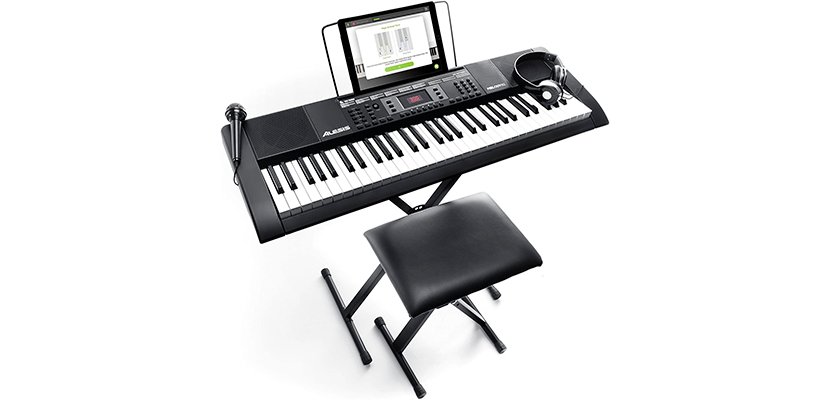
Alesis is known for providing the elaborated teaching pianos, and the Melody 61 is not an exception and can work great as a beginner keyboard. However, it looks like a professional studio instrument. It has an LCD display and built-in speakers and a microphone which is very useful if you are not only a pianist but also a singer, headphones for private practice, stand, foldable stool, power adapter (the piano can also be powered via 6 AA batteries), and a music rest for holding sheet music. The stand is easy to assemble, and the stool also has three adjustable height settings. The built-in speakers are not loud enough for performing on the stage but will definitely work great for home practice.
The Alesis Melody 61 is a model that has 61 keys. Since it features 300 instrument tones (piano, strings, brass, percussion, mallets, guitars, and others) and 300 rhythms, it can possibly be the best piano keyboard for creating your own original compositions as those options allow for very extensive editing and give the possibility to play almost any types of compositions. Besides, these 300 built-in tones also have two modes: Layer (to layer multiple sounds together) and Split (to split two sounds). You can also use 40 provided demo songs or record your own as there is also a recording and playback feature.
As a beginner keyboard, the Alesis Melody 61 offers a 3-month free subscription to Skoove Premium special online interactive piano-teaching courses that provide exclusive piano lessons from a team of experienced musicians. It also includes a huge catalog of music of different genres.
Pros
- The control buttons are large and clear, so it’s very convenient to press them.
- The keyboard is very easy to remove from the stand.
- The keys are easy to press which is good for small kids.
Cons
- The instrument voices don’t sound natural.
- The microphone is loud and you can’t adjust its volume independently of the instrument.
RockJam RJ761
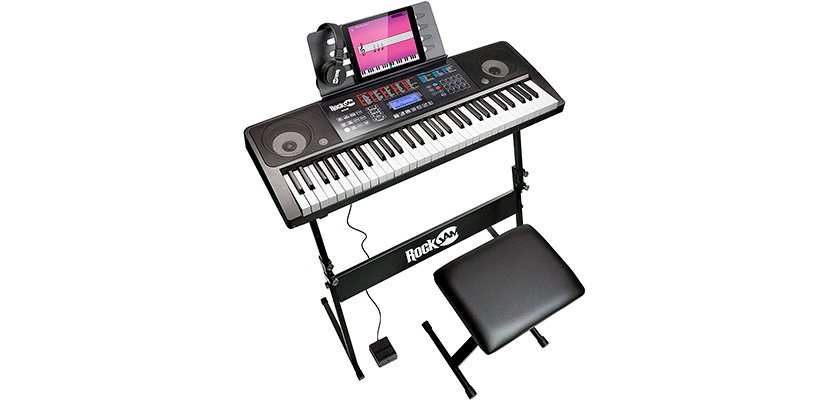
This model from RockJam is an interactive teaching keyboard piano that can be powered via power supply or batteries. It has an LCD screen and built-in speakers and goes in a large kit with an adjustable X-shaped stand, folded padded stool, sustain pedal, and headphones. The sustain pedal makes the notes sound for longer, so you can create almost any compositions you wish.
The RJ761 can be the best keyboard to learn piano as it has 61 full-size keys that give an acoustic piano feel while also featuring a lot of advanced features that greatly simplify the process of learning. For example, a soft-touch display panel which has 200 rhythms, 200 tones (piano, piccolo, organ, and many others), a teaching function, and 30 demo songs. The teaching function helps understand the chords and how they are constructed.
Besides, all of these features are easily accessible thanks to highly-responsive and clearly labeled touchscreen which is also illuminated. Plus, as an advanced device, it also has record and playback functionality.
This model also includes three different types of control: Effect, Control, and Accompaniment Control. They are very useful for adding more style to your music.
If connectivity versatility is what matters to you, you may consider this model as the best piano keyboard since it has MIDI output, as well as AUX input. Thanks to MIDI output, the RJ761 can work with a lot of digital audio software (like Ableton, for example).
Along with the keyboard, you will also get exclusive access to the Simply Piano app (iOS/ Android compatible) which helps in learning the piano.
Pros
- The kit includes the key note stickers which show the right keys to play.
- The rhythm programming function allows creating the base for your pieces.
- The quality of keyboard keys is very good for the price.
Cons
- The provided sit is a bit flimsy.
- The access to the Simply Piano app is free for one week only.
Casio CTK-2550 PPK
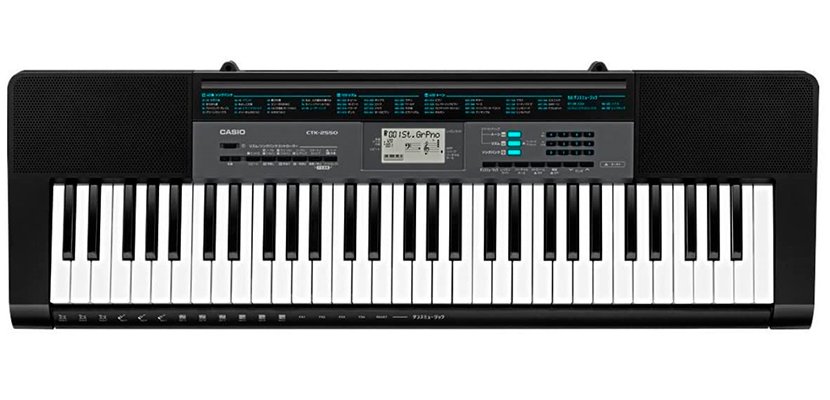
This Casio piano keyboard goes with an LCD display, built-in speakers, closed-cup Samson HP30 headphones, a X-shaped stand, and a Casio ADE95 keyboard power supply. It has 61 full-size keys and can be powered via 6 AA batteries or via an included AC adapter. There are ports for pedal, headphones or external speakers, and audio input.
The included Samson HP30 headphones are lightweight and feature a closed-back design and an adjustable headband. They have 40mm full-range drivers, 20Hz – 20kHz frequency response, and an impedance level of 32 Ohms, being suitable not only for this keyboard piano but also for a variety of other applications (with the guitar or MP3 player, for example).
The stand is made of heavy-duty steel and has non-marking rubber-end caps. It can withstand the maximum weight of 130 pounds, so it can hold not only the 61 keys piano but also 76- and 88-key keyboards. Its height can be adjusted from 25.25 to 38.75 inches, so it can be used for both seated and standing performance. It also can be fully closed for easy storage.
The CTK-2550 PPK has 400 tones and 150 rhythms, so it’s one of the best piano keyboards for musical exploration. They allow adding drum beats, hall, bass lines, reverb, synth parts, filter, flanger, and other effects to your music. This keyboard also has a Dance Music mode with the help of which you can create and mix electronic dance music with ease.
You can connect your iOS/Android device to the keyboard and use the free Chordana Play app which shows how to play different songs.
Pros
- The Chordana Play app allows transferring downloadable MIDI files to the keyboard’s internal memory.
- There are 48 levels of maximum polyphony.
- The Lesson function includes a scoring system, lesson lite, and voice fingering guide.
Cons
- You can’t use this keyboard with rechargeable batteries.
- The sound seems a bit synthetic.
Alesis Recital
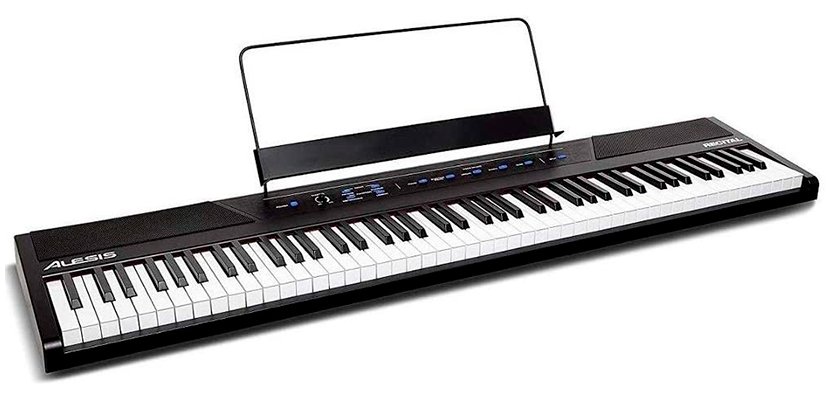
The Alesis Recital has 88 full-sized keys, just like a traditional acoustic piano. They are semi-weighted and it’s a pleasure to press them. The keys also have an adjustable touch response, being suitable for different playing styles.
The present model can be the best 88-key keyboard piano for those who are searching for a simple digital model as a replacement of a full-sized piano. Its interface is very simple: it has two dedicated buttons to add chorus and reverb effects, five voice select buttons (piano, electric piano, organ, synth, bass), and Split mode button.
This model is also suitable for learning the piano as it has powerful educational features. They include fully-adjustable Metronome mode (tap tempo from 30 – 280 beats per minute) and Lesson mode. The Lesson mode is perfectly suitable for learning the piano with a teacher as it allows playing together by dividing the keys into two zones. Plus, buying this 88-key keyboard piano, you will also get a 3-month premium subscription to Skoove — a website which provides interactive online piano lessons with experts. It also has a curated catalog with the music of all genres.
This electric keyboard piano goes with the music rest and has powerful built-in 20W speakers. The headphones aren’t included in the kit, but there is a headphone output. Plus, there are also a USB output to use the piano with virtual instrument plugins and educational software, sustain pedal input, and two RCA outputs to connect the piano to external speakers, amplifier, mixer, or recorder. This model can be powered via an included power adapter or 6 D-cell batteries (not included).
Pros
- All the buttons are illuminated with bright blue LED light.
- The built-in speakers work great as for an entry-level model and ensure clear, room-filling sound.
- This keyboard is velocity-sensitive, so you can change the volume and pitch with the intensity of your play.
Cons
- The headphones output is not standard (6.35mm).
- There are no pre-recorded songs.
- This keyboard piano doesn’t come with a stand, so it’s not convenient for on-stage performances.
Video Alesis Recital
Hamzer

This 61-key model is designed for beginners or students with an intermediate level of playing and provides a traditional piano feel. It comes with a set of transparent stickers that label the keys, making it easier to play. This model is also one of the best piano keyboards for mastering finger control as it allows playing single-fingered and fingered auto-bass chords. Besides, the keys are touch-sensitive.
This keyboard piano goes in a large kit which includes over-the-ear headphones, microphone, sturdy metal stand with 3-position adjustable height, foldable stool, and a detachable sheet music stand.
This model has 255 timbres, 255 rhythms, 61 keyboard percussions, and 24 demo songs. There are also such effects as vibrato, sustain, and ensemble. Some additional functions include rhythm sync and tempo adjustment. You can also choose the chord timbre and program/edit rhythm. The record and playback feature is also available.
The piano features an LCD display and an intuitive and extensive control panel, with dedicated control buttons for tempo, vibrato, sustain, etc. There are also built-in stereo speakers. However, if you want a more loud and more powerful sound, there is a stereo output that allows connecting the external speakers to the piano.
The present model can be powered via 6 AA batteries or US-standard 110 – 120V power adapter (included).
Pros
- The piano has some interesting additional features like, for example, fill-in temp.
- There are 6-keyboard percussions.
- The keyboard offers the backup beats.
Cons
- The keys are not of the same size as the keys on an acoustic piano which is not good for those beginner pianists who are planning to play on a traditional piano in the future.
- The speakers sound disordered at max volume.
Casio SA-76
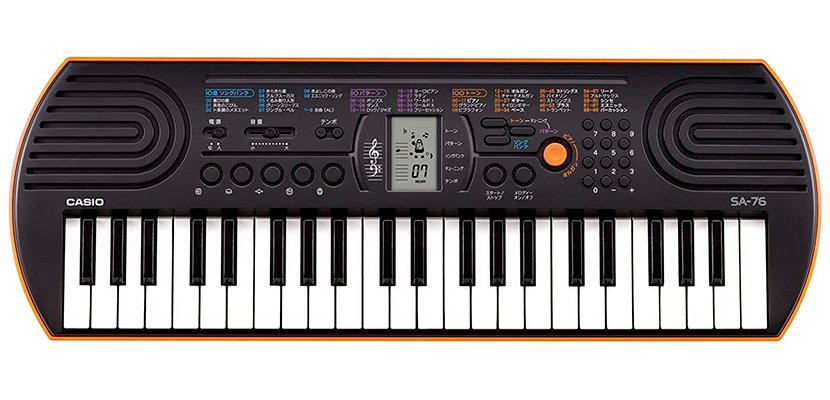
The Casio SA-76 is a cheap, beginner-friendly mini keyboard piano which, however, provides quite universal functionality with a lot of features. It has only 44 mini-sized keys, designed for little fingers, so it can be a great option for kids. This tiny keyboard can be powered via 6 AA batteries, so you can just place it on your thighs and play anywhere you like.
The connectivity options are very limited: you will only find an amp output (0.8+0.8 watts) and an output for headphones (not included). The 8-note polyphony provides the sound of decent quality but doesn’t encourage serious playing.
The piano has an easy-to-read LCD display with an LED backlight where you can see the notes you play (it also helps with the selection of music options) and a pair of very weak built-in 1.2W speakers.
This model has 100 sounds (piano, guitar, saxophones, and much more), 50 beats which range from waltz to salsa, 10 songs to play along with which offer the opportunity to learn a great range of styles, and 5 drum pads. There are five dedicated buttons for drum sounds which can be used at the same time as the keys.
The interface is easy, with clearly-labeled buttons. You can easily select the tone thanks to the large orange button which allows switching between Piano and Organ sounds. There is also a melody on/off lesson function which provides effective training for the right hand.
This keyboard piano goes with a music songbook, useful for learning how to play different melodies.
Pros
- The display offers convenient learning options.
- The tutorial/demo tracks are not hard for kids.
- The keyboard can be bought in one of three available colors: grey, orange, or pink.
Cons
- The piano goes without an AC power cord.
- The keys are not pressure-sensitive and don’t feel very realistic.
- Most sound options are quite childish.
Video Casio SA-76
Yamaha P71
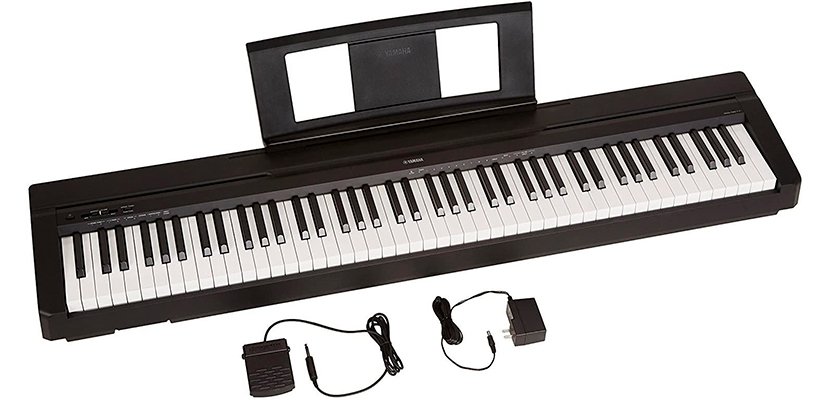
This full-size piano keyboard features 88 fully-weighted keys that perfectly simulate the feel of an acoustic piano. A pair of built-in 6W speakers is located at the bottom of the keyboard.
The Yamaha classic sound engine provides an Advanced Wave Memory sampling feature that uses digital technology to record the sound of an acoustic piano. It creates deep, rich, and more spacious sound thanks to L and R waveforms that are captured with two microphones. This feature can also be used for changing the level of volume and timbre.
This weighted keyboard piano has very simple controls. Except for the power button and volume control, there is only one button to switch between voices, play demo sources, configure the metronome, etc.
The provided ten voices include digitally-sampled premium tones from Yamaha acoustic pianos. There is also a Dual mode which allows combining two sounds (like piano and guitar, for example), so you can play compositions of different styles. This model also features four different settings for the key sensitivity — fixed, medium, soft, and hard.
This Yamaha keyboard with 88-keys goes with a power adapter and a sustain pedal. It has a USB port, jack for sustain pedal, and an input for headphones.
Pros
- You can buy this model in a kit with a home bundle which includes a keyboard stand that makes it look like a traditional piano.
- It has a convenient slim design so it doesn’t take a lot of space.
- The piano includes an adjustable auto power-off feature so it will shut off after a certain period of inactivity.
Cons
- The headphones jack is located on the rear side of the piano and it’s difficult to access.
- Its features and sound may limit an advanced player.
- This keyboard piano doesn’t have a display which is not very convenient considering the number of features.
Video Yamaha P71
Yamaha Ypt260
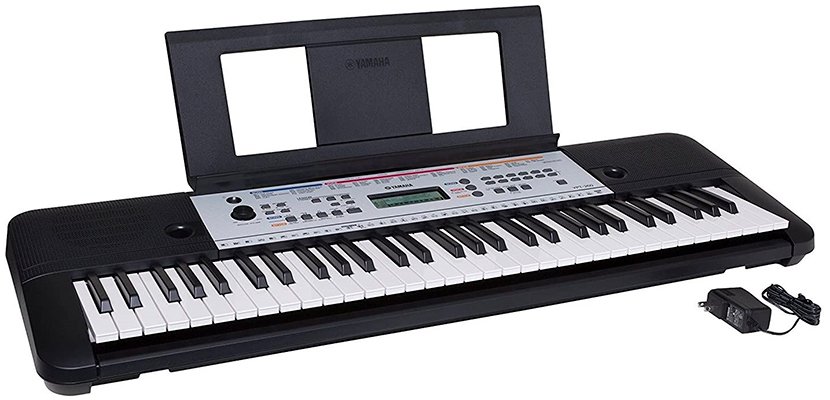
This Yamaha keyboard with 61 keys is designed for the entry-level pianists. However, it features a large control panel with 400 voices, 130 auto-accompaniment styles with backing tracks, 112 songs, and a record/playback functionality. This way, when you become an advanced player, it will still remain relevant. Although it doesn’t sound like an acoustic piano, the quality is definitely decent as for an entry-level beginner model.
This piano has a special Education Suite feature with 9-step lessons and a free downloadable songbook. Besides, there is also a Duo mode, which is great if you have a teacher/learning partner.
The keyboard features an Advanced Wave Memory stereo sampling which provides a high-quality recording and filtering.
The YPT260 has five chorus settings and nine types of reverb effects which allow for more extensive possibilities to customize your sound. The LCD display is easily readable.
This model has an AUX input, so you can connect the piano to your phone, tablet, or computer and play along with the music from it. It also has a jack for headphones and a sustain pedal. The kit includes the PA130 power adapter, but you can also get 6 AA batteries and turn this keyboard piano in a portable device.
Pros
- The phrase recorder allows storing your ideas and songs.
- The built-in speakers feature the amplification boost tones.
- The Master EQ offers six styles for customization and three types of ultra-wide stereo.
Cons
- There is no touch sensitivity.
- The keys are narrower than standard ones.
Roland
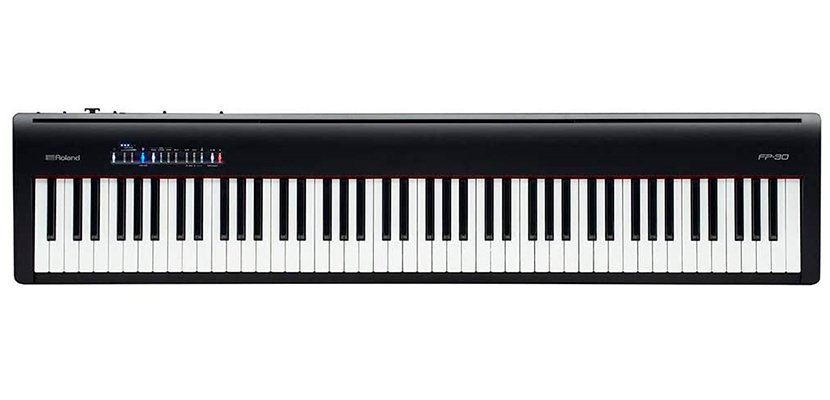
Roland keyboards are known for providing a rich and responsive tone. This model uses the Roland renowned piano engine, ensuring a high-end sound. It’s available in two classical piano colors — black and white.
The keyboard has 88 ivory feel keys with quiet action. It features a powerful amplifier and a pair of 11W stereo speakers. In terms of functionality, this model has preloaded 30 songs, Dual and Split modes, as well as a great variety of sound effects, like an organ, strings, drums, etc. There is also a Twin mode for lessons with a teacher which divides the keyboard into two parts with the same octave ranges. The SMF recorder allows recording your melodies.
This model has an output for headphones, sustain pedal jack, and two USB ports: USB computer and USB memory. The piano also provides a connection via Bluetooth. This way, you can wirelessly connect your phone to the piano and use it along with many useful apps.
This USB piano keyboard goes with the KSC-70 stand that provides the classic piano look, and the KPD-70 three-pedal unit for enhanced functionality.
Buying this model, you will also get three months of free online piano lessons from Skoove. Additionally, if you register your Roland piano on the Roland website, you will get unlimited access to all the songs and courses.
Pros
- The foot pedals can be used for hands-free music page turning (via special apps, like piaScore/Sheet Music Direct).
- This model offers a great variety of drum patterns.
- Five types of touch sensitivity.
Cons
- There is no WAV/MP3 recording via USB.
- There is no visual display.
Video Roland
Yamaha PSR-E-363
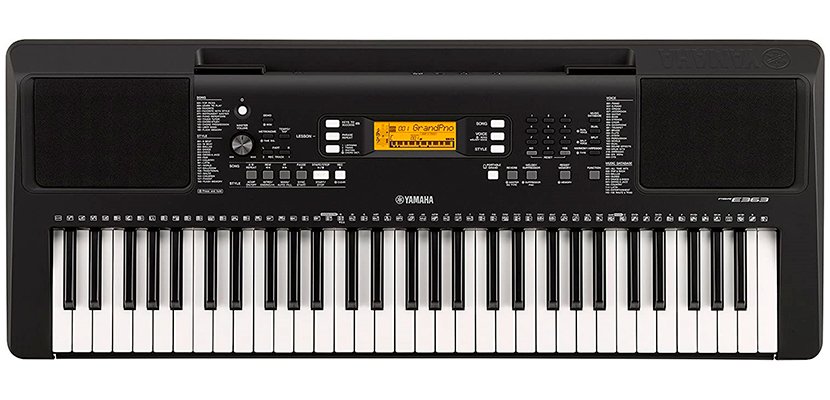
This Yamaha keyboard piano with 61 touch-sensitive keys provides louder tones. Also, it can be a great purchase for beginners and amateurs. For learning purposes, the PSR-E-363 includes the onboard lessons. The LCD display will guide you through these lessons.
With the USB-to-host terminal, you can connect the keyboard to a computer or portable device and record audio in high quality without any additional interface. The USB connectivity also allows transferring MIDI and audio files.
The PSR-E-363 functionality offers 574 instrument voices (339 XGlite voices, 197 panel voices, 20 arpeggio voices, and 18 drum effects) for any music genre. 165 auto-accompaniment styles provide backing tracks that are based on the chords you are playing in real-time. The Duo mode creates two middle C notes that allow two people to play together on one piano.
The Yamaha Education Suite is a set of educational features which allow practicing your playing with the preset songs or MIDI files from a compatible with the piano device.
There are a headphones output and a port for a pedal. This model is powered via a standard power adapter which, however, is not included in the kit.
Pros
- The piano features 12 levels of reverb and 5 types of the chorus.
- There is a melody suppress feature which removes vocals from the tracks.
- The Keys to Success feature includes a collection of teaching techniques.
Cons
- The LCD screen is unreadable at an angle.
- The built-in speakers are quiet and not of great quality.
Video Yamaha PSR-E-363
Yamaha PSR-EW300 SA
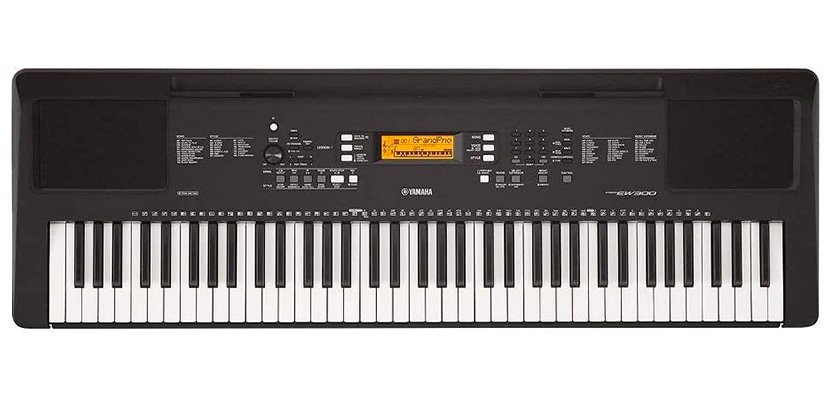
This 76-key piano with touch-sensitive dynamic keys features great functionality which includes 574 voices, 165 auto-accompaniment styles, and 154 preset songs. The playback and record feature is also included. There are also Dual, Split, and Duo keyboard functions.
The PSR-EW300 SA has a backlit easy-to-read LCD display and a pair of 12-inch speakers.
The keyboard also features Yamaha Education Suite — a set of features, aimed to teach the user different useful musical skills. The Touch Tutor Lesson mode monitors the velocity or strength with which you press the keys and teaches you the right dynamics. Free downloadable songbook includes musical scores of the built-in songs and also provides onboard lessons with images and glossary.
The PSR-EW300 SA features a headphone jack, sustain pedal jack, AUX in stereo mini-jack, and a USB-to-host port.
This model goes with an X-shaped stand, music rest, and PA130 power supply but also can be battery-powered with 6 AA batteries.
Pros
- The Master EQ has many settings which allow creating and customizing sounds as you prefer.
- You can easily save and store your settings thanks to One Touch feature.
- There is the possibility to record up to five songs due to the memory card.
Cons
- The accompaniment sounds are too loud.
- The inbuilt speakers aren’t as strong as the ones in many similar models.
Video Yamaha PSR-EW300 SA
Buyer’s Guide
Main Keyboard Features You Should Consider Before Buying
Since the keyboard piano is not an acoustic but digital instrument, there are a lot more features to consider before buying. They include the number of keys, key actions, MIDI compatibility, and many others. Let’s take a closer look at these features.
Number of keys
The most multifunctional, as well as the largest pianos, have 88 or 76 keys. A full-size keyboard piano contains 88 keys and covers seven octaves and three notes. If accuracy is what matters to you, go for it. If you need a more portable option, a 76-keys piano, which covers six octaves and three notes may be just what you need. However, you may not be able to play some classic compositions (Beethoven, Chopin, etc.) and some popular 20th-century compositions (Debussy, Prokofiev, etc).
If you are limited in space, you can choose a 61-key piano which covers five octaves. It will definitely limit you in some way, but, on the other hand, Mozart, for example, created his compositions using a 61-key piano.
The models with less than 61 keys are highly-portable and can even easily fit on your thighs, but they provide very limited possibilities. However, they are quite good for learning purposes, especially for kids.
Action
Since the keyboard pianos don’t have the same parts as the acoustic pianos, they use different techniques to recreate the feel of a real piano. Such techniques refer to key actions which are the mechanisms of the piano, responsible for sound production. The advanced models use or replicate versions of moving parts, used in traditional pianos. However, note that such models are pricier and heavier, but, however, still cheaper and more portable than the traditional pianos.
The key actions include the hammer action which gives an identical to the acoustic piano feel thanks to the usage of a mechanical hammer which moves each key. It’s normally used in the expensive keyboard pianos of the highest quality. However, the keys with the built-in weighted weights also provide the feel, identical to the real piano. The semi-weighted key action combines weight and spring-loaded action. However, it doesn’t provide a great dynamic. The cheapest option is unweighted/synth action which uses plastic keys where resistance is created with the help of springs.
MIDI compatibility
One of the most convenient things about digital keyboard pianos is the fact that they allow for recording. The recording is extremely useful for regular musicians, songwriters, as well as for practicing your pieces. Usually, the recording is possible thanks to the ability to connect the piano to your PC via a USB cable. However, some models offer MIDI connectivity which allows using your keyboard piano as a controller for your MIDI/virtual instrument software. The keyboard pianos used to have the 5-pin MIDI sockets, but the modern models normally use a USB connectivity for recording and software handling.
Additional features
A keyboard piano is a complex unit which, depending on the model, can offer a lot of different features. Some of them include:
- Touch or velocity sensitivity. It’s the ability of a keyboard piano to feel the force/speed with which you press the key.
- Polyphony. It’s the number of sounds that the piano can create at one time.
- Multitimbrality. It’s the ability of a piano to create different sounds at once (drums, strings, piano, etc.).
- Sequencer. It’s a hardware/software device that is designed to record a MIDI performance data and then play it back in a programmed order.
- Arpeggiator. It automatically creates an arpeggio (a chord, which notes are played sequentially) when a single note is played on the piano.
- Sampler. It records digital audio and gives the ability to edit it and then play it back in different ways. It’s useful for incorporating external audio clips.

Hi everyone! I’m Thomas Moody, also known as Guitarzan.
